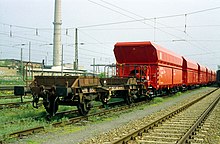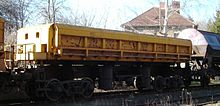Special wagons (type U freight wagons)
In the genus U are based on the type designation system for goods wagons of the UIC those freight cars grouped of special designs that do not belong to the genera F, H, L, S or Z.
These are (in descending order according to the number of units at DB):
- Container wagons for the transport of powdery goods,
- Transfer car between different coupling systems ( coupling car ),
- Low-loader wagons including carrying spout wagons,
- Hopper trolleys with loading flaps as well
- the test cars of the RoadRailer and Kombirail systems for combined transport .
Between 1964 and 1979, the container wagons for the transport of liquid and gaseous goods ( tank wagons ) were assigned to the Uh type, before the type Z, which was common on the German state railways until 1964, was reintroduced internationally in this context in 1980.
Container wagons for the transport of powdery goods (dust wagon)

The dust wagon is a special container wagon that is set up to transport dust-like goods. These trolleys are unloaded pneumatically, mostly using compressed air. For goods that can react with the oxygen in the conveying air, nitrogen is usually used. These wagons are used for goods that are so fine-grained that they cannot or only poorly flow and thus gravity discharge is not possible, for example cement. As rail freight wagons, they have the generic letter U with the addition c. They normally do not have a conveying air generator and are therefore dependent on an external air supply.
Coupling car
Coupled wagons became necessary after networks on which vehicles with different coupling systems were used touched and wagons were to be used continuously for the time being. If the scope of the wagon transition is limited, the provision of coupling wagons on one of the two networks is more cost-effective than equipping all transition-capable wagons with floor frames for both coupling systems. Coupling wagons were required between the central and western European standard and the eastern European broad gauge network after the latter had been converted to type SA-3 central buffer couplings and newly built freight wagons were no longer designed for the installation of side buffers. For a long time, old, two-axle freight wagons were used, especially tank wagons, which were equipped with an SA-3 coupling at one end and were usually used in pairs. With the commissioning of the Mukran – Klaipėda ferry connection , the wagon throughput of structurally broad-gauge freight wagons in the standard gauge network was to be significantly expanded. The relatively few existing coupling wagons were outdated, and the length of the train should not be increased by too long coupling wagons. The use of existing flat wagons (in Finland and on the Berlin S-Bahn, Ks- flat wagons are used as coupling wagons, and Rgs or Res flat wagons are used by the vehicle industry, which can also be used for material transport). The Deutsche Reichsbahn had new coupling wagons built at Waggonbau Altenburg on the basis of underframes for two-axle tank wagons . They were weighed down with concrete ballast, received an SA-3 coupling with a pendulum return device at one end, but a side buffer, screw coupling and a brakeman's platform with handbrake at the other end and were classified as Us . In later-built wagons, the concrete ballast blocks were replaced by packages of old concrete sleepers.
After 1990 the volume of goods wagons throughput decreased sharply, but in Germany more wagons with central buffer couplings were needed for heavy ore trains between the seaports and the steelworks. The existing coupling wagons were initially adapted as a makeshift for transfer journeys and the covering with locomotives that are not equipped with central buffer couplings. The end of the wagon, which had previously been equipped with an SA-3 coupling, was fitted with a screw coupling and side buffer that was inserted into the pendulum suspension. A central buffer coupling of the Intermat type was installed at the end of the handbrake . In order to make it easier to use the pairs, which are still required, the Deutsche Bahn had the head pieces with SA-3 mount also brought up to the UIC standard and Intermat coupling heads installed. The side buffers were retained at both ends of the wagons, and the wagons were given loose mixed couplings at both ends. Turning trips are no longer necessary.
The Deutsche Bundesbahn used Ks wagons previously loaded with concrete ballast blocks, from which the wooden wagon floors and the hinged side panels had been removed.
Flatbed wagons
These freight wagons are designed for the large-capacity and heavy transport of goods that would not keep the clear space on normal freight wagons. This group has a wide variety of designs, ranging from two-axle low-loader wagons to 36-axle flatbed wagons.
The current genre of all Tiefladewagen is Ui and can optionally be substituted by the letters a , aa , k , kk , or s are complements. The load limit is not coded as a code letter for flatbed wagons. The former German wagon type was St or SSt .
In 1998 a total of 180 flatbed wagons of 43 different types were employed at DB . They serve u. a. for transporting combine harvesters , generators or narrow-gauge vehicles .
Tragschnabelwagen

The largest low-loader wagons are designed as carrying wagons, which consist of two completely separate parts. Each part is carried by multi-axle bogies or groups of bogies. Beak-like support arms are supported on it, which in turn carry a deeply lowered loading platform or are directly connected to the mostly very large cargo. In this case, the load itself is a temporary load-bearing component of the vehicle. The vehicles have hydraulic equipment with which the load can be lifted or shifted horizontally in order to maneuver past obstacles. There are around 30 specimens each in Europe , North America and Asia .
Typical goods to be transported are large power plant boilers , turbine parts or machine transformers for power plants. Because of the heavy weight and oversize of the loads, these transports can usually not be carried out with normal freight trains . They run as special trains and require careful preparation. As soon as the wagon and its load have transport restrictions due to dimensions and weight, it is referred to as an " exceptional shipment ", which is labeled with a "U sample" according to RIV . Without a load, the two support arms are directly connected to one another; the vehicle can then travel on freight trains at normal speed.
| Type designation |
Maximum load capacity |
cycling rates |
Pieces paid a |
|---|---|---|---|
| Uis 632 | 25 t | 2 | 25th |
| Uiks 635 | 19 t | 2 | 27 |
| Uais 732 | 50 t | 4th | 16 |
| Uaai 812 | 159 t | 10 | 1 |
| Uaai 820 | 157 t | 12 | 1 |
| Uaai 821 | 190 t (180 t b ) | 12 | 1 |
| Uaai 823 | 230 t | 16 | 1 |
| Uaai 831 | 275 t (250 t b ) | 20th | 2 |
| Uaai 836 | 317 t | 20th | 1 |
| Uaai 837 | 398 t | 24 | 1 |
| Uaai 838 | 341 t (313 t b ) | 24 | 1 |
| Uaai 839 | 454 t | 32 | 1 |
Hopper trolley with loading flaps
A number of funnel-shaped self-unloading wagons are classified as special wagons. Their external design corresponds to the open hopper wagons , but they have a closed roof with loading hatches and therefore do not meet the criteria for a wagon with an opening roof .
The DB has some of the DR acquired Kaliwagen with four loading flaps under the genus queued Uaoos-y. Some of these cars have already been equipped with swivel roofs.
A large number of grain wagons are in use at the SNCF , which are grouped as special wagons.
Side-tilting trolleys
Sideways-tipping wagons are also rarely classified as special wagons if they do not meet the criteria for an open freight wagon of the special design .
Individual evidence
Web links
- Side- tipping wagons in the Czech archive parostroj.net
Literature and media
- Stefan Carstens : The DB AG freight cars. MIBA, Nuremberg 1998, ISBN 3-86046-030-7




